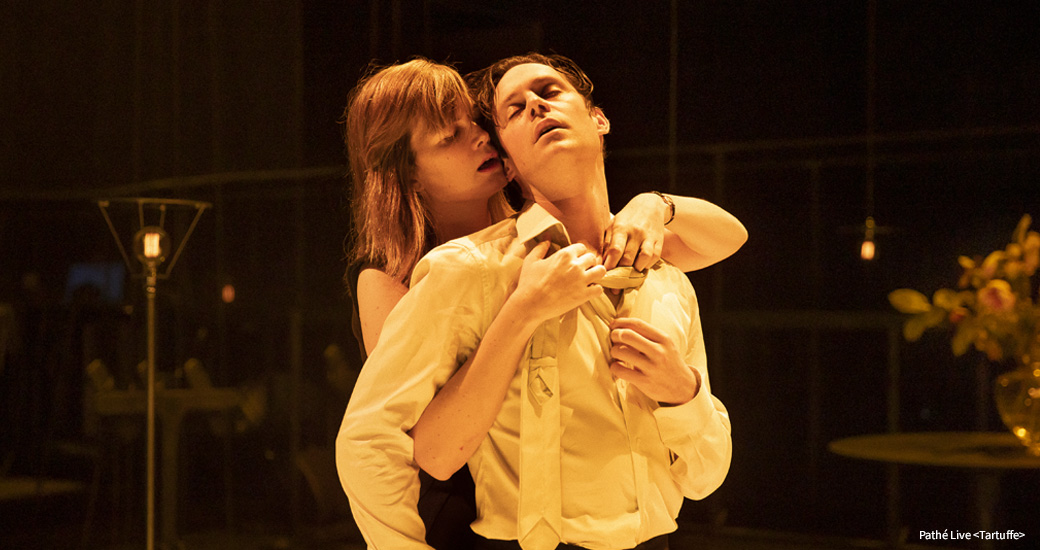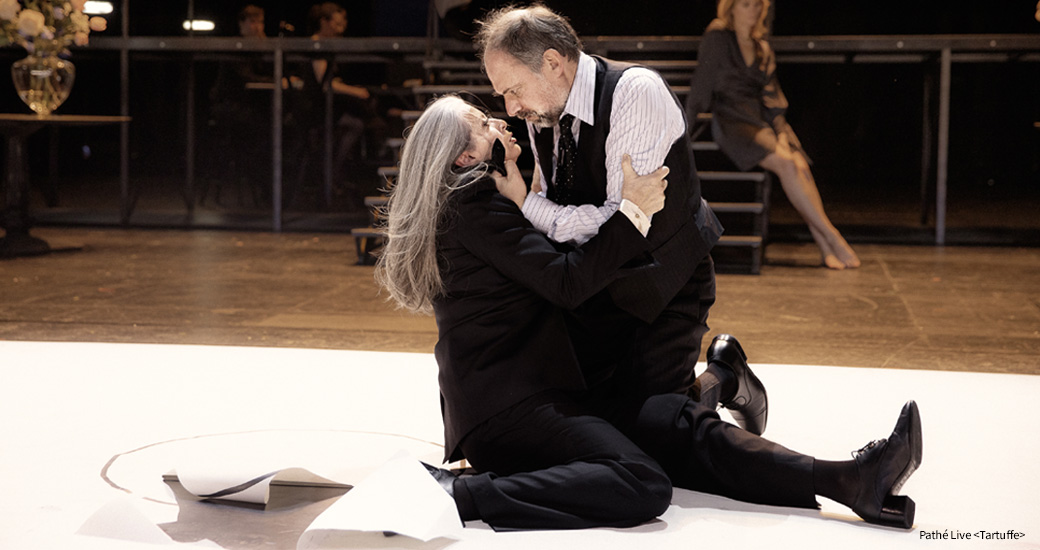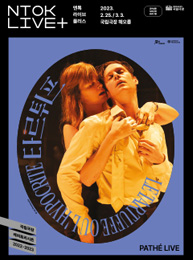내일의 전통, 오늘의 관객을 만나다
월간국립극장
-
내일의 전통 SPOTLIGHT 더보기
-
무대, 탐미 STAGES 더보기
- 미리보기, 하나 - 국립극장 기획공연 <나는 재미있는 낙타예요> 구음과 판소리가 펼쳐낼 감각의 스펙트럼
- 미리보기, 둘 - 가치 만드는 국립극장 국립창극단 <작창가 프로젝트> 시연회 판소리를 위한 헌정곡
- 미리보기, 셋 - 국립무용단 <묵향> 고전으로 꽃피운 명작
- 미리보기, 넷 - 국립국악관현악단 <2023 윈터 콘서트> 색다른 만남
- 미리보기, 다섯 - 파크컴퍼니 <고도를 기다리며> 저녁의 게임, 기다림의 규칙
- 미리보기, 여섯 - 국립극장 기획공연 <세종의 노래 : 월인천강지곡> 세 가지 시선: 거장들의 만남
- 미리보기, 일곱 - 국립극장 <송년판소리> 세말에도 덩실덩실
-
안목의 성장 INSIGHT 더보기
-
극장 속으로 INTO THEATER 더보기

몰리에르 코메디 중에서 <수전노> <스카팽의 간계>와 더불어 프랑스인들이 가장 사랑하는 작품 중 하나인 <타르튀프 혹은 위선자>(이하 <타르튀프>)는 1664년 5월 12일 베르사유궁전에서 초연되었지만, 일반인에게는 공연이 금지돼 있었다. 1667년 8월 개작본을 팔레 루아얄 극장Théâtre du Palais Royal에서 1회 공연했으나 이후 공연이 금지되고, 18개월이 지난 1669년 2월에 재공연돼 커다란 성공을 거두었다.
<타르튀프>의 공연이 금지된 것은 몰리에르가 이 작품 속에서 종교인을 ‘위선자’로 공격하고 조롱하기 때문이다. 물론 이 시기 루이 14세는 국가권력의 휘하에 놓이지 않은 가톨릭교회에 대해 호의적이지 않았지만, 또 한편으로는 가톨릭 내에서 예수회에 대립하는 얀선주의Jansenism를 이단화하는 결정을 내리면서 가톨릭교회의 예수교 주류를 보호하는 이중적 태도를 보이고 있었다. 이와 같은 모호한 종교적 입장을 지닌 루이 14세는 결국 가톨릭과 완전히 대립하지 않기 위해서 <타르튀프> 공연 금지를 요구하는 파리 대주교의 뜻을 받아들일 수밖에 없었다.

1669년 문제의 소지를 없애기 위해 다듬은 판본이 출판되고 이후 이 공연본이 <타르튀프> 공연의 정본이 되었다. 초연본은 잊히고, 더는 기록조차 남지 않게 되었다. 하지만 2021년 저명한 17세기 문학 연구자 조르주 포레스티에Georges Forestier 교수에 의해 초판본이 복원돼 출판된다. 이 판본은 1664년의 초판본이라 할 수는 없지만 여러 가지 자료를 통해서 조르주 포레스티에 교수가 상상으로 복원·각색한 판본이다. 1669년 판본이 5막 구성을 지닌 것과 달리 초판 복원본은 3막 구조를 지니고 있다. 즉 5막 중 오르공의 딸과 그녀의 연인 장면인 2막 그리고 국왕의 명령으로 타르튀프를 처벌하는 5막이 생략된 형태의 작품이다.
이와 같은 장면이 줄어든 것 이외에 1669년 판본과 1664년 초연 복원판본의 결정적인 차이는 ‘타르튀프가 언제부터 위선자로서 제시되는가?’이다. 1669년 판본에서는 타르튀프는 원래 사기꾼이고 위선자이다. 그러므로 직업적 사기꾼인 그는 종교인으로 치장한 채 오르공 집에 들어와 오르공의 재산을 자신의 것으로 만들고, 부인을 유혹하는 행태를 벌인다. 이와 같은 설정 속에서는 위선은 타르튀프라는 개인의 문제이지 종교인 일반의 문제가 아니다. 그런데 1664년 판본에서 타르튀프는 종교인으로서 독실한 신앙을 지닌 인물이지만, 엘미르의 아름다움에 매료되어 그의 본성적 욕망을 제어하지 못하고 그녀를 유혹하기에 이르며, 신앙을 배반하고 위선적으로 죄를 무마하려는 태도를 보인다. 이와 같은 설정 속에서 그의 위선은 개인만의 문제가 아니라 독실한 신앙인들이 보편적으로 당착하는 모습이다. 그러므로 몰리에르의 초판본은 독실한 신앙인들은 필연적으로 위선에 빠지게 된다는 종교적으로 매우 독설적인 비판을 내보이는 것이며, 바로 이 때문에 가톨릭교회는 <타르튀프>의 공연을 금지할 것을 국왕에게 요구한 것이다. 보편적인 인간이 지닌 모순뿐만 아니라, 동시대 구체적 상황 속 인간의 모순을 포착하고 이를 신랄하게 비판하는 몰리에르의 진면모가 초판본에서 더 잘 드러난다고 할 수 있다.

하지만 이보 반 호프 연출은 ‘종교적 위선자’로서의 타르튀프에는 큰 관심을 두지 않는다. 세속화라는 가치가 헌법상의 가장 중요한 가치 중 하나인 현대 프랑스에서 종교인의 위선은 17세기처럼 중요한 문제가 아니다. 그렇다면 이보 반 호프는 어떤 ‘위선’을 이 작품 속에서 보여주려 하는 것일까?
이보 반 호프에게 타르튀프는 오르공의 집에서 무전취식을 하고, 그 집 돈을 갈취하려고 한다는 점에서 ‘거지’로 정의할 수 있는 인물이다. 작품 서두에 노숙자인 타르튀프를 집으로 데려와 목욕시키는 설정은 바로 이와 같은 인물 이해의 결과다. 그러므로 이보 반 호프가 타르튀프를 노숙자로 설정한 것은 노숙자와 관련된 사회적인 시각에서 이 작품에 접근하려 한 것은 아니다. 이보 반 호프의 관심은 동시대적 관점에서 ‘가족’이라는 단위의 유효성을 향한다. 이제껏 견실해 보이던 오르공 가정이 타르튀프라는 변수의 등장으로 인해 그 관계의 위선을 노출하게 되는 것, 이것이 이보 반 호프가 파악하는 ‘위선’의 주체다. 결국 이보 반 호프는 현대 이전의 가치에 대한 담보로서, 전통적 사회의 기초단위로서 가족이 과연 유효한지를 질문하고자 하는 것이다. 이 집안의 가장 연장자인 페르넬 부인이 바로 전통적 가치관을 대변한다. 그리고 아들인 오르공은 가장임에도 불구하고, 어머니의 영향에서 벗어나지 못한다. 엘미르 부인의 설정에서 이보 반 호프는 그의 시각을 강조한다. 엘미르 부인은 더는 사기꾼인 타르튀프의 계략으로부터 가정을 지키려는 정숙하고, 슬기로운 여인으로 그려지지 않는다.
그렇다고 이보 반 호프가 텍스트를 변형시키는 것은 아니다. 텍스트를 변형시키지 않으면서도 욕망에 충실한 캐릭터로 엘미르라는 인물을 구축함으로써 연출가는 전혀 다른 <타르튀프>를 만들어낸다. 엘미르의 욕망을 추동하기 위해서 타르튀프라는 인물도 종교인으로서의 창백한 이미지가 아니라 육체적 아름다움을 지닌 인물로 제시된다. 첫 장면에서부터 오르공 저택으로 들어와 목욕을 하고 새로운 옷으로 갈아입기 전 그의 나신이 관객에게 공개되는 것은 이처럼 욕망의 대상으로서의 육체를 드러내기 위해서였다. 그 유명한 테이블 장면은 엘미르의 욕망을 적나라하게 보여준다. 원래 테이블 장면은 테이블 밑에 숨은 오르공이 엘미르를 유혹하는 타르튀프의 위선을 목도하는 대목이다. 그런데 이보 반 호프의 연출 속에서 오르공이 목격하게 되는 것은, 그리고 오르공과 함께 관객들이 목도하게 되는 것은, 유혹하는 타르튀프만큼이나 적극적으로 그의 구애를 받아들이는 엘미르다. 그리하여 결말이 타르튀프를 쫓아내고 원래의 안정된 가족의 모습으로 돌아가는 것 역시 아니다. 사건의 전말이 드러났음에도 불구하고 이를 받아들이지 않는 어머니 페르넬 부인이 지탱하는 이 가정은 이제 무의미하다. 쫓겨나는 타르튀프가 이 집의 진정한 주인은 이제 자신이라 외치는 것은 그저 그의 계략을 드러내는 장치이거나 분노하는 그의 감정을 보여주는 장면이 아니다. 무대 가운데 자신을 이 집의 새로운 주인으로 선포하는 그를 향해 등장인물들이 도열한다. 그러므로 이보 반 호프는 타르튀프가 스스로 이 집의 주인임을 선포하는 이 외침을 관객에게 들려주고 싶었던 것이다.
이제 오르공의 가정은 무너졌다. 3막의 마지막 구절이 끝나고, 대사 없이 연출가가 덧붙인 장면은 이를 잘 보여준다. 여기엔 임신한 엘미르와 타르튀프 그리고 노숙자 차림의 오르공 등이 등장한다. 추가된 엔딩을 이해하기 위해 아이의 아버지가 누구인지, 아니면 이들이 오르공의 집에서 쫓겨난 것인지와 같은 인과관계에 상상력까지 동원할 필요는 없다. 여기서 중요한 것은 전통적 가치에 기반한 ‘집’ ‘가정’이 더는 존재하지 않는다는 것이다. 전통적 가치의 가족을 이처럼 붕괴시키면서 이보 반 호프는 도그마에 기초하지 않는 새로운 형식의 가족을 제시하고 싶어 한다.
이미지. Pathé Live 〈타르튀프〉 ⓒJan Versweyveld
번역. 이재은

French is referred to as the 'language of Molière'; the Comédie Française, one of the state theaters in France, is known as the 'house of Molière.' As these examples demonstrate, Molière, who was an actor, playwright, and head of a theater company, is an iconic figure in French culture. The year 2022 marked the quadringentenary of Molière's birth. Celebrating the anniversary, the Comédie Française presented a special season dedicated to Molière. Amongst the season programs,

<Tartuffe or the Hypocrite> (hereinafter referred to as <Tartuffe>) is one of the most beloved comedies by Molière in France, along with <The Miser> and <Scapin's Deceits>. <Tartuffe> was premiered at the Palace of Versailles on May 12, 1664, but it was forbidden to the public. In August 1667, a revised version was performed once at Théãtre du Palais Royal, but again the play was banned from being performed. And then eighteen months later, in February 1669, it was performed once again, finally achieving a great success.
<Tartuffe> was forbidden because Molière accused the pious of their hypocrisy and mocked them in the play. At the time, King Louis XIV was not favorable to the Catholic Church, which was obviously not under the king's control, but he was not hostile to it, either. Rather, the king took an ambivalent attitude toward the Church by declaring Jansenism as a heresy and thereby protecting the Jesuits, the mainstream sect in the Catholic Church. King Louis XIV could not reject the request of the archbishop of Paris to suppress the performance of <Tartuffe>, in order to avoid conflicts with the Catholic Church.
In 1669, a re-written version of the play, in which all the problematic parts had been deleted or revised, was published, and this has been regarded as the standard version of <Tartuffe>. The original version of the play was totally forgotten, with no records left. In 2021, however, Georges Forestier, renowned scholar of 17th century literature, published a restored original version of the play. While the 1669 version was in five acts, this restored version consists of only three acts, omitting act 2, in which Orgon's daughter and her lover appear, and act 5, in which the king orders Tartuffe to be punished.
Besides the omission of these two acts, the fundamental difference between the 1669 version from the restored one lies in the point where Tartuffe begins to be portrayed as a hypocrite. In the 1669 version, Tartuffe is portrayed as a fraud and hypocrite by nature. Tartuffe, a fraud, disguises himself as a pious man to get the chance to stay at Orgon's house, and then makes Orgon's possessions his own and seduces his wife. In this storyline, hypocrisy is Tartuffe's own moral defect, not a general problem of the pious. In the 1664 version, however, Tartuffe, although he was a pious man in the beginning, becomes attracted to Elmire, fails in overcoming lust, and ends up seducing her; finally, he betrays the faith, even trying to cover up his crimes. And this character arc conveys the message that Tartuffe's hypocrisy is not a single individual's personal flaw but a universal problem of every pious man. Given this context, Molière's first version of the play was surely meant to be a harsh critique against the innate hypocrisy of the pious, which was why the Catholic Church requested the king to suppress the play. Molière not only wanted to criticize a universal flaw of common men but also intended to capture the moments of self-contradiction from his contemporaries in a specific situation, and this intention of the playwright is better realized in the original version of the play.

Interestingly, however, Tartuffe as a religious hypocrite is not what Hove mainly cares about in his production. Given that secularization is one of the most essential values in the current French Constitution, hypocrisy of the pious is not so important a matter as it was in the 17th century. What kind of 'hypocrisy' then does Hove intend to deal with in his production?
Hove identifies Tartuffe as a 'beggar': Tartuffe freeloads at Orgon's place and even tries to extort his money. And that's why they have Tartuffe, a beggar or a vagrant, take a bath when he firstly came to Orgon's house at the beginning of the play. But providing a certain commentary about the social issue of the homeless is not what Hove tries to do in this play. Rather, the director tries to rethink the validity of 'family' from a contemporary perspective. Orgon's family looks wholesome and morally grounded at first, but since Tartuffe shows up, it is revealed that the familial relationships between them are only built upon hypocrisy. This is the subject of hypocrisy Hove tries to capture. In other words, the director tries to ask if family, a basic unit of the traditional society, is still valid in today's society. Madame Pernelle, the eldest of the family, represents such traditional values. Her son, Orgon, is the patriarch of the family, but he does not get out of his mother's control. It is the character of Elmire that epitomizes the director's intention. In Hove's production, Elmire is not a wise, virtuous woman who tries to protect her family from Tartuffe's evil schemes.
This does not necessarily mean that Hove has altered the text. Without making any changes to the script, the director produces a wholly different version of <Tartuffe> especially by characterizing Elmire as a woman true to her own desire. Here, Tartuffe is a man attractive enough to evoke Elmire's desire, and therefore is depicted as a physically appealing figure, rather than as a pallid religious one. In the opening scene where Tartuffe takes a bath and then changes into a new clothing, his naked body is exposed to the audience, which is a theatrical device to present his body as an object of desire. On the other hand, the famous table scene explicitly reveals what Elmire wants. In the previous productions, Orgon, hiding under a table, witnesses Tartuffe seducing Elmire and therefore realizes his hypocrisy. But in Hove's production, what Orgon, along with the audiences, witnesses is that Elmire succumbs to Tartuffe's temptation as willingly as Tartuffe seduces her. In the ending of the standard version, Tartuffe is thrown out and Orgon's family goes back to normal, but this is not the case in Hove's ending. Even when the whole affair is revealed, Madame Pernelle is refused to accept the truth and tries to keep the family together, but it is meaningless to sustain the family that way. Tartuffe, being banished from the house, proclaims that now he is the real owner of the house, and this scene is not intended to foreshadow his upcoming scheme nor to express his anger. When he proclaims himself as a new owner of the house, Tartuffe is at the center of the stage while the other characters are lining up toward him. These stage directions indicate Hove's intention that the real target of Tartuffe's proclamation is no one but the audience.
Eventually, Orgon's family is destroyed. This is well demonstrated in the ending, which is added by the director to the last scene of Act 3 and proceeds in total silence. Here appear Elmire, who's pregnant, Tartuffe, and Orgon, who looks like a vagrant now. In order to understand this newly added ending, we don't need to try to figure out who the father of Elmire's child is, or whether Orgon has thrown them out of his house. What is important here is that there is no 'home' or 'family' in the traditional definitions of the words. Hove tries to deconstruct the conventional concept of family and suggest a newly constructed, undogmatic one.
Image. Pathé Live <Tartuffe> ⓒJan Versweyveld
월간지 '월간 국립극장' 뉴스레터 구독 신청
뉴스레터 구독은 홈페이지 회원 가입 시 신청 가능하며, 다양한 국립극장 소식을 함께 받아보실 수 있습니다.
또는 카카오톡 채널을 통해 편리하게 '월간 국립극장' 뉴스레터를 받아보세요.
※회원가입 시 이메일 수신 동의 필요 (기존회원인 경우 회원정보수정 > 고객서비스 > 메일링 수신 동의 선택)







